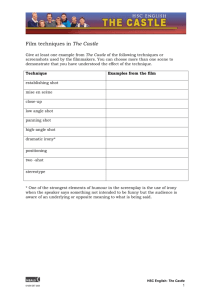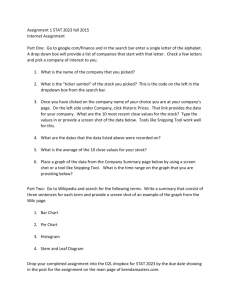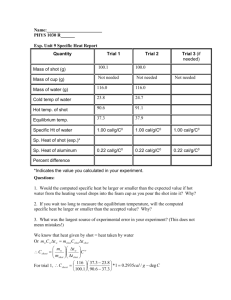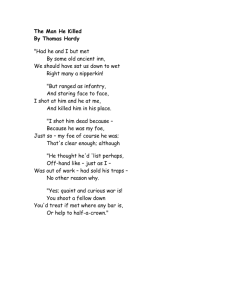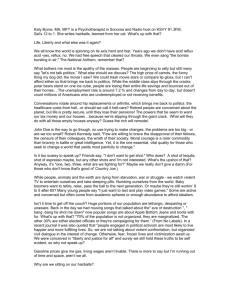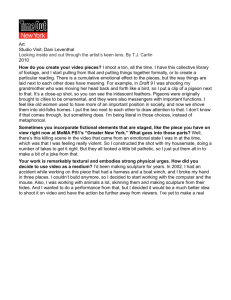Specific Heat - BGSU Physics & Astronomy
advertisement
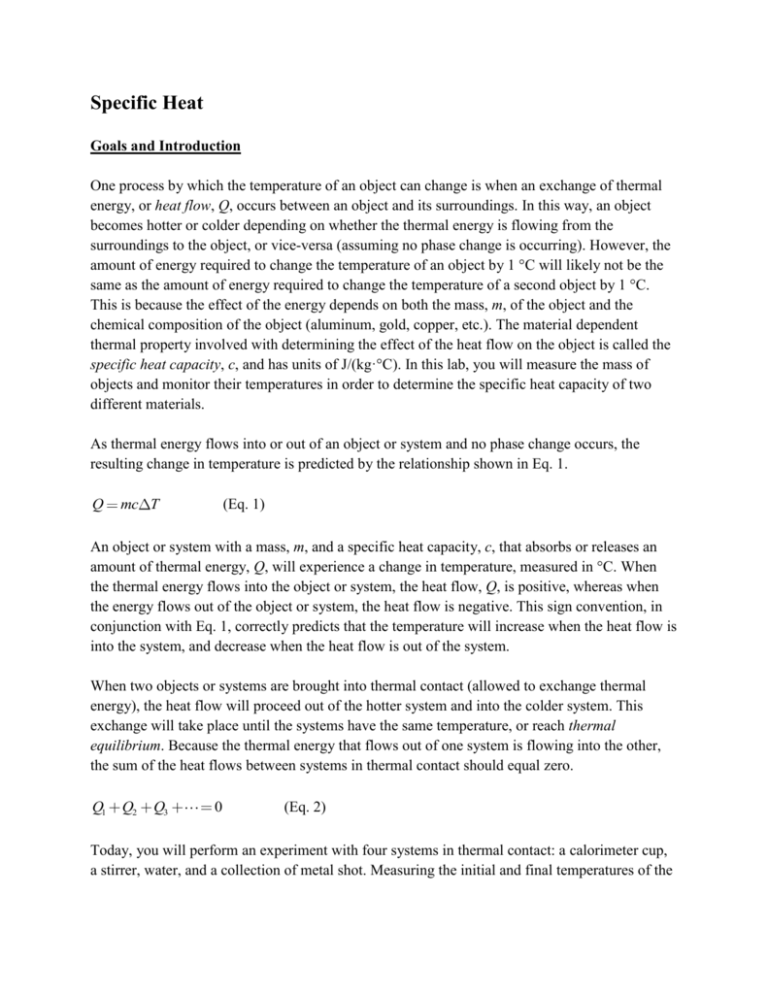
Specific Heat Goals and Introduction One process by which the temperature of an object can change is when an exchange of thermal energy, or heat flow, Q, occurs between an object and its surroundings. In this way, an object becomes hotter or colder depending on whether the thermal energy is flowing from the surroundings to the object, or vice-versa (assuming no phase change is occurring). However, the amount of energy required to change the temperature of an object by 1 °C will likely not be the same as the amount of energy required to change the temperature of a second object by 1 °C. This is because the effect of the energy depends on both the mass, m, of the object and the chemical composition of the object (aluminum, gold, copper, etc.). The material dependent thermal property involved with determining the effect of the heat flow on the object is called the specific heat capacity, c, and has units of J/(kg·°C). In this lab, you will measure the mass of objects and monitor their temperatures in order to determine the specific heat capacity of two different materials. As thermal energy flows into or out of an object or system and no phase change occurs, the resulting change in temperature is predicted by the relationship shown in Eq. 1. Q (Eq. 1) mc T An object or system with a mass, m, and a specific heat capacity, c, that absorbs or releases an amount of thermal energy, Q, will experience a change in temperature, measured in °C. When the thermal energy flows into the object or system, the heat flow, Q, is positive, whereas when the energy flows out of the object or system, the heat flow is negative. This sign convention, in conjunction with Eq. 1, correctly predicts that the temperature will increase when the heat flow is into the system, and decrease when the heat flow is out of the system. When two objects or systems are brought into thermal contact (allowed to exchange thermal energy), the heat flow will proceed out of the hotter system and into the colder system. This exchange will take place until the systems have the same temperature, or reach thermal equilibrium. Because the thermal energy that flows out of one system is flowing into the other, the sum of the heat flows between systems in thermal contact should equal zero. Q1 Q2 Q3 0 (Eq. 2) Today, you will perform an experiment with four systems in thermal contact: a calorimeter cup, a stirrer, water, and a collection of metal shot. Measuring the initial and final temperatures of the systems, and knowing the specific heat capacities of the cup, stirrer, and water, you will be able to calculate the specific heat capacity of the metal shot. Goals: (1) (2) Develop your understanding of thermodynamic equilibrium and heat exchanged between systems in thermal contact. Identify unknown metal materials by experimentally determining the specific heat capacities of the substances. Procedure Equipment – Bunsen burner with stand, a tray, paper towels, double boiler, balance, two thermometers, a double-walled calorimeter, glass stirrer, lead (Pb) shot, and aluminum (Al) NOTE: The lead shot is the smaller-sized of the two types of shot. If you are unsure which is which, be sure to consult your TA. 1) The calorimeter consists of an exterior cup, a lid, and an interior cup with a lip so that it can hang from an insulating ring. Measure and record the mass of the interior cup. Be sure that the insulating ring is not stuck to the cup when you measure its mass. In this experiment, we will assume the cup is made of brass or copper and has a specific heat capacity of 385 J kg C . 2) Pour cold tap water into the interior calorimeter cup until it is about 2/3 full. Then, determine the mass of the water. Measure and record the mass of the water. Note that the specific heat capacity of water is 4186 J kg C . 3) Place the lid on the calorimeter cup and place one of the thermometers into the water. 4) If not already done, lay the lead shot out on a paper towel on the tray and try to get the shot as dry as possible. 5) The double boiler has a slender interior cup that will be used to hold the shot as it is heated. Use this slender interior cup to measure out about 400 g of the lead shot. Record the mass of the shot that you end up using in the cup. Keep the shot within the slender cup for heating. 6) The other part of the double boiler is the tank. Place water into the tank until it is half-full and light the Bunsen burner, placing it below the tank. 7) Place one of the thermometers into the shot (still in the slender cup) and place the cup into its slot in the double boiler so that the shot begins heating. 8) After the water in the double boiler is boiling and the thermometer in the metal shot seems to have stabilized (stopped increasing), record the temperature of the shot and label it as Tshoti. Also, record the initial temperature of the water in the calorimeter and label it as Twi. Turn off the Bunsen burner. 9) Remove both thermometers. Remove the calorimeter lid and then quickly but carefully lift the slender cup containing the hot shot from the double boiler and pour the metal shot into the calorimeter cup with as little splashing as possible, so as not to lose any water. Cover the calorimeter with the lid. 10) Place the thermometer from the water back into the water through the hole in the lid of the calorimeter and hold it. Be sure that the thermometer does not touch the metal shot during this part of the experiment. 11) Use the glass stirrer through the lid to lightly stir the shot while the system consisting of the calorimeter cup, the water, and the shot reaches thermal equilibrium. Once thermal equilibrium is reached, record the final temperature of the systems. 12) After checking and drying off the aluminum shot, place a new paper towel in the tray and dump out the lead shot to dry. 13) Repeat steps 2-11 for the aluminum shot. Be sure to note that any data you record during this step are for the aluminum shot experiment. As always, be sure to organize your data records for presentation in your lab report, using tables and labels where appropriate. Data Analysis We will first analyze the experiment with the lead shot. Compute the change in temperature for the lead shot, the water, and the calorimeter cup. Compute the heat flow, Q, for the water and the calorimeter cup. Now, use Eq. 2 to compute an experimental value for the specific heat capacity of the lead shot. Perform the same analysis as above to determine an experimental value for the specific heat capacity of the aluminum shot. Error Analysis The accepted value for the specific heat capacity of lead is 128 J kg C . Compute the percent error in the first experiment, using your experimentally derived specific heat capacity of lead. The accepted value for the specific heat capacity of aluminum is 900 J kg C . Compute the percent error in the second experiment, using your experimentally derived specific heat capacity of aluminum. Question 1: Suppose that 400 g of both lead and aluminum shot were to be heated until their temperatures changed by 100 °C. Which substance would require more energy to accomplish this task? Explain your answer. Question 2: In this experiment we did not take into account the mass or composition of the stirrer. If we did take this into account, would it cause the result for the specific heat capacities to be greater or less? Explain your answer. Questions and Conclusions Be sure to address Questions 1 and 2 and describe what has been verified and tested by this experiment. What are the likely sources of error? Where might the physics principles investigated in this lab manifest in everyday life, or in a job setting? Pre-Lab Questions Please read through all the instructions for this experiment to acquaint yourself with the experimental setup and procedures, and develop any questions you may want to discuss with your lab partner or TA before you begin. Then answer the following questions and type your answers into the Canvas quiz tool for “Specific Heat,” and submit it before the start of your lab section on the day this experiment is to be run. PL-1) What heat flow in Joules is necessary to change the temperature of 0.50 kg of water from 25 °C to 45 °C? [Hint: the specific heat capacity of water is 4186 J kg C ] PL-2) In the previous problem, a heat flow changed the temperature of 0.50 kg of water from 25 °C to 45 °C. If the specific heat capacity of water was larger than its typical value of 4186 J kg C , which of the following statements would be true? (A) The change in temperature of the water would be greater. (B) Less energy is needed to change the temperature from 25 °C to 45 °C. (C) The water’s temperature would not change (D) More energy is needed to change the temperature from 25 °C to 45 °C. PL-3) A heat flow of 45, 000 J changed the temperature of a certain mass of water from 25 °C to 45 °C. If the heat flow came from 350 g of lead shot, what must have been the heat flow, Q, in Joules for the lead shot? [Hint: the specific heat capacity of water is 4186 J kg C , and the specific heat capacity of lead is 128 J kg C ] PL-4) Heated lead shot is added to cold water, and the temperature of the water rises. If the heat flow into the water, Q, is 3850 J and the mass of the lead shot is 350 g, what is the temperature change of the lead shot (in °C)? [Hint: the specific heat capacity of water is 4186 J kg C , and the specific heat capacity of lead is 128 J kg C ] PL-5) When two thermodynamic systems at different temperatures are brought into thermal contact and are otherwise isolated from their surroundings, the sum of the heat flows for the two systems is (A) negative. (B) equal to zero. (C) positive. (D) undefined.


